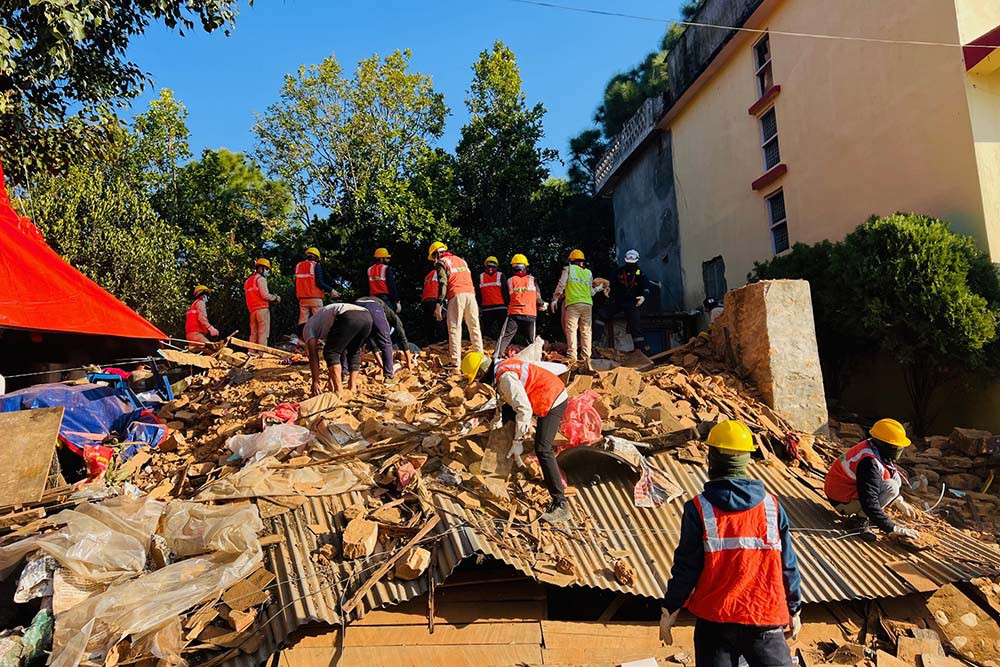
Nepal is known as a land of living cultures and traditions. Among the various reasons that travelers come to Nepal for, pilgrimage is a big one. People across the globe visit Nepal to experience the beautiful holy sites and be part of the religious festivals. Hinduism and Buddhism have coexisted in deep harmony and flourished as a message of peace.
As tourism has evolved over the years, travel and trade operators in the country have marked the significance of religious tourism and built it as a product. The government as well has recognised the importance of this segment and is giving high priority to developing and preserving historical religious sites while promoting bi-lateral, sub-regional and regional level collaboration for the promotion and development of the religious places which have a shared history. The dialogue between India and Nepal for the development of Ramayana Circuit, Shiva Circuit and Buddhist Circuit are examples of this endeavour.
Developing Buddhist Circuit is not only limited to two nations, the 4th BIMSTEC Summit held in Kathmandu in August this year decided to develop a roadmap for the promotion of Buddhist circuit among BIMSTEC members. As Nepal embodies important and integral sites of Hindu and Buddhist saga, Nepal has immense potential to develop and promote religious tourism.
The Buddhist Circuit
Lumbini is the birthplace of Lord Buddha and an auspicious and holysite for Buddhists. The Lumbini Development Trust has been working for the preservation of the Buddhist site in the country and developing the Buddhist circuit inside the country. Along with Lumbini, the Trust has come up with the Greater Lumbini Master Plan that covers Buddhist sites located in Kapilvastu: Tilaurakot (palace of Prince Siddhartha), Nilihawa, Gotihawa, Kuran and Sagrahawa; Rupandehi (Lumbini, Devdaha) and Nawalparasi (Ramgram).
Ramgram is preserved by the Lumbini Development Trust, the Buddhist pilgrimage site contains relics of Gautam Buddha. Devdaha is located 57 kilometers east of Lumbini. It is believed that Buddha stayed there during his tours and preached to monks on various topics. “The aforementioned places are covered by the Greater Lumbini Master Plan for the preservation and historical sites and to develop the physical facilities for tourists to have easier access,” said Saroj Bhattarai, Acting Member Secretary of Lumbini Development Trust and added, “The trust has plans to operate electric buses granted by the Government of China on these routes to provide tourists, who come to visit Lumbini, easy access to the other Buddhist sites in the region.”
Nita Pokharel Aryal, Joint Secretary of the Ministry of Culture, Tourism and Civil Aviation explained that the government has given priority and allocated resources for the development of the Greater Lumbini Region and urged travel and tour operators to develop tourist packages accordingly. “The rest of the places apart from Lumbini need publicity. If these sites are included in tour packages and brochures and websites of travel and tour operators, tourists who come to Lumbini can get to know about these holy sites as well,” she said. She further stated that the Ministry has planned to expand the Buddhist circuit to Swoyambhunath, Boudhanath in Kathmandu and Namobuddha of Kavre district to the east and Kakrebihar (Surkhet) and Mahendranagar (Kanchanpur) in the west.
Bi-lateral Initiatives
Buddha was born in Lumbini, he was enlightened in Bodhgaya (India), most parts of his life Buddha spent preaching to students who later turned into monk/nuns at Sarnath (India). Buddha, ultimately, died in Kushinagar (India) and his relics were brought to Ramgram of Nawalparasi.
With this background, the Government of India has proposed Nepal to develop the Buddhist circuit integrating these holy sites which were important in the life cycle of Lord Buddha. India has proposed joint promotion of the circuit so that the Buddhist tourists coming to India can visit every historical sites, including Lumbini and the tourists coming to Nepal can visit the holy sites in India.
A Joint Working Group was formed comprising of the tourism ministry officials of both countries headed by the joint secretaries. It also included tourism entrepreneurs and experts. Ghanashyam Upadhyay, who heads the joint working group (JWG) from Nepal side, said that Nepal has also proposed to include six holy sites of Kapilvastu, Devdaha and Ramgram apart from Lumbini. There have been rounds of negotiations regarding joint promotion of Buddhism and Buddhist holy sites that fall in the territory of Nepal and India. If agreed, it will be sold as travel packages by travel and tour operators operating in Nepal and India. “We are looking into a win-win scenario for both countries allowing tourists to come to each other’s country to visit the entire Buddhist circuit,” said Upadhyay. There have been arguments in the public sphere that if Nepal allows India to include Lumbini in the travel package for tourists coming to India, the flow of tourists coming to Nepal to visit Lumbini will decline because Indian tourism entrepreneurs will offer the visit of Lumbini as well to Buddhist tourists around the world coming to India.
Nepal-India bilateral initiatives for promotion of Hindu sites
Ramayana Circuit
Nepal and India have strong socio-cultural ties since time immemorial. The marriage between Prince Ram of Ayodhya (India) and Princess Sita of Janakpur (Nepal) as told in the Hindu mythology has opened up linkages between the two historical cities of Nepal and India. During his visit to Janakpur in May this year, the Indian Prime Minister Narendra Modi had announced promoting Ramayana circuit to strengthen the religious ties between the two countries. During the visit of the Indian Premier, both Prime Ministers of Nepal and India, KP Sharma Oli and Narendra Modi, inaugurated the direct bus service from Janakpur to Ayodhya and vice versa.
The Indian government has identified 15 destinations in India for development under the Ramayana Circuit namely Ayodhya, Nandigram, Shringverpur and Chitrakoot (Uttar Pradesh), Sitamarhi, Buxar and Darbanga (Bihar), Chitrakoot (Madhya Pradesh), Mahendragiri (Odisha), Jagdalpur (Chattisgarh), Nashik and Nagpur (Maharashtra), Bhadrachalam (Telangana), Hampi (Karnataka) and Rameshwaram (Tamil Nadu). The Ramayana Circuit will also include Janakpur, where the 20th century Janaki temple is located.
Shiva Circuit
A destination of one of the Hindu trinity, Lord Shiva, Pashupatinath is located in the capital of Nepal. The country has proposed its southern neighbour where the largest number of Hindu population are living to develop the Shiva circuit connecting Pashupatinath with holy sites of Lord Shiva in India, namely Kedarnath, of Uttarakhand. Pashupatinath is the guardian spirit and the holiest of all Shiva shrines in Nepal. Pashupatinath is one part of Dwadash Jyotirlinga of Kedarnath Jyotirlinga temple. Every year scores of Indian Hindu pilgrims visit Pashupatinath temple. Many Indian tourists come to Kathmandu to visit Pashupatinath during their visit to Kailash Mansarovar via Nepalgunj.
Tourist inflow grows in 2018
The country has witnessed exponential tourist growth in the first 10 months of 2018. A total of 882,531 tourists have visited Nepal between January and October of this year compared to 757,448 tourists who visited Nepal during the same period in 2017. Tourist arrival has grown by 16.5% compared to last year. According to the Department of Immigration, 109,733 tourists have visited Nepal in October only.
The tourist flow in the ten months is a milestone in achieving the target of one million tourists set by the Ministry of Culture, Tourism and Civil Aviation. The Ministry has in fact assumed one million tourist flow in 2017, which was not met with a count of 940,218 in 2017, as per Nepal Tourism Board.
In 2018, a large number of Indian tourists 161,963 visited Nepal. Since the enforcement of Goods and Services Tax (GST), charges of the hotels in India have skyrocketed as Indian government defines the hotel services (tourist standard hotel) as luxury service. Thus, in part Nepal became the choice of holiday destination for Indians for seminar, incentive tours, weddings. Hotels and party venues at the border points get better businesses from India during wedding season, according to hotel entrepreneurs.
During the review period, 121,418 Chinese tourists visited Nepal. Similarly, 73,677 tourists came from the United States of America and 50,161 from United Kingdom. Flow of tourists from South Asian neighbours Bangladesh and Sri Lanka are also peaking in recent years. A total of 46,280 Sri Lankans and 21,110 Bangladeshis have visited Nepal in this period. Germany is one of the major contributors in terms of tourist flow as 30,086 German nationals and 25,518 from France visited Nepal during January to October. South Korea emerged as popular source country as 27,690 Korean passport holders visited Nepal in this period. Likewise, 27,459 people visited Nepal from Thailand and 12,110 from Japan. Above 10,000 visitors from Malaysia, Spain, Italy, Canada and Netherlands visited Nepal during first 10 months of 2018.





